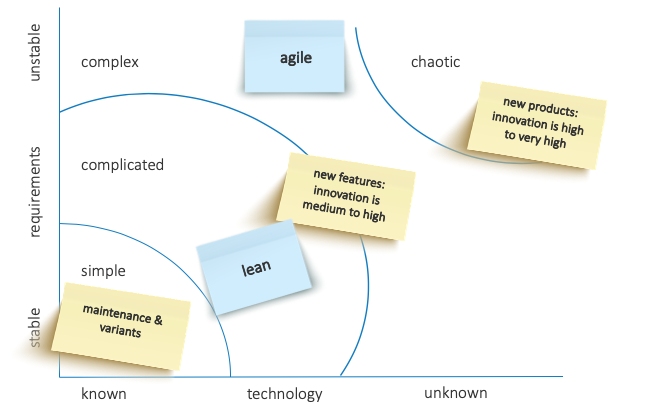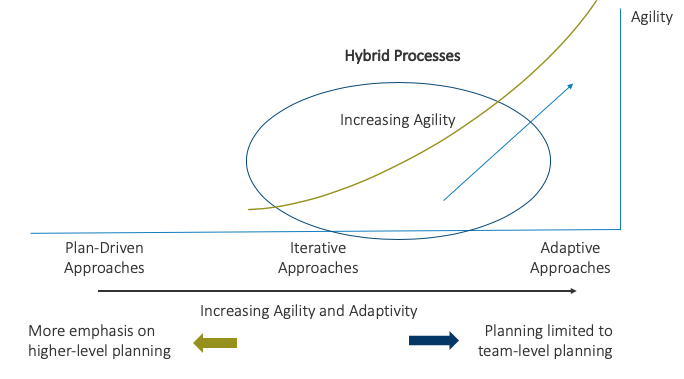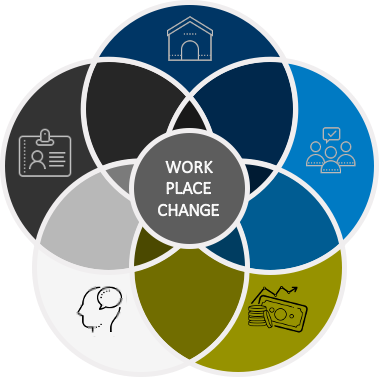New working environments (7) - room and hybrid processes
In the seventh part of the series New Working Environments we deal with the requirements of hybrid processes in organisations on the environment, i.e. space.
Between waterfall and agility
Processes in organizations define the way the company reacts to customer requests (or deals with itself). In the industrial age - in complicated contexts - processes were often set up according to the model of a waterfall: project sequences based on each other are planned and implemented step by step with corresponding milestones.
Workplace changes, in the VUCA world, as we have been experiencing for many years, are often taking place too slow. In ever shorter periods of time and iterative cycles, companies must adapt to the permanent beta of globalized markets.
The associated complexity is best countered with agile processes. One reason why agility has become a trend for years - not only in software development.
On the other hand, traditional processes (LEAN, waterfall) are quite helpful under conditions that can be standardized as far as possible, such as in production plants. No wonder, then, that the unilateral increase in agility to solve all problems had to cause surprise and contradiction.
What is meant by hybrid processes?
The term "hybrid" usually stands for a combination of two different aspects and is used in numerous disciplines. It is most frequently used in technology (hybrid drive systems, hybrid computers, hybrid software, etc.), but it can also be found in economics (hybrid bonds, hybrid business models), zoology (hybrid - crossing), political science (hybrid systems) and many other disciplines.
We speak of hybrid processes when a combination of different approaches makes sense in order to enable value creation under changing conditions. Hybrid processes should be like the abdominal circumference: not too bloated and not too lean. Bloated makes sluggish, lean makes fragile. Hybrid processes distinguish between controllable-mechanical and living-dynamic environmental conditions. They include the possibility for continuous adaptation to the respective context.
Following the well-known Cynefin model (D. Snowden), one could say in simple terms: The more complex the world is, the more agile approaches can contribute to solving existing challenges - the simpler the environmental conditions in the sense of being more predictable, the more likely it is that classical processes (waterfall, LEAN) will be applied sensibly (see Fig. 1).
Figure 1: Process selection and context conditions (following Snowden, Cynefin model)
The key lies in the balance between flexibility and stability. What is controllable and routinely always runs the same way can be described. Complex challenges require above all creativity and a step-by-step approach (see Fig. 2).

Figure 2: Hybrid project management approach (Source: High Impact Project Management)
Effects on space - the five effective elements
Even in ancient times, five active elements were defined for the house, which have lost nothing of their validity for the company of today (see Fig. 3):

Figure 3: The five active elements of the house (following Kulick, Quarch, Teunen)
Protection
![]()
Rooms protect us and have an effect through their atmosphere. This atmosphere lies below our conscious attention. We are always exposed to these influences. Good design has an appreciative and uplifting effect.
When teams work together in an agile way, they need space to visualize their sprints. Furthermore, they need communication areas to exchange ideas and hold workshops in order to optimally develop their potential and to support them.
In a protected atmosphere, in which one can speak openly and make mistakes, this effective element can be experienced process-wise.
Feeling of togetherness
![]()
"All real life is encounter" (Martin Buber)
Each room creates its own atmosphere and mood. These have an effect on harmony and conviviality. Since people like to connect with other people, the office shapes the quality of the feeling of togetherness.
In projects - whether linear or iterative - (cross-functional) teams working on the same value creation should therefore also work together spatially. Very often, however, in traditional production facilities, e.g. in the automotive industry, the offices are separate from the production plant.
But here too, there are lighthouses, such as BMW's "Future Mobility Lab", which consciously take different approaches to strengthen the feeling of togetherness. In the new building the offices will be directly connected to the plant to create proximity between management and production staff and improve collaboration on the same value stream.
If, for example, a new motor drive is to be developed, all the teams involved, such as marketing, purchasing, production and logistics, can work together at the same location, so that daily meetings are possible.
Identity foundation
![]()
Identity refers to the conscious connection with meaningful experiences. We connect with a company, its members and groups. Intelligent interior design promotes identification and belonging.
Using the example of the motor drive unit project team, by mixing blue and white collar employees, all have a common goal and identify with the product. Through the common goal and the work on the same value creation, the common identity also increases.
Nota bene: The processes taking place can be of a hybrid nature, as is most appropriate for the respective value stream section.
Profitability
![]()
Profitability is the basic condition and expression of intelligent value creation. Interior design has a considerable influence on the value creation processes in a company. Digitalisation creates increased efficiency, sensible room formats and new forms of collaboration.
Processes are a significant factor in the profitability of a company. If they are not agile where necessary, slower decisions lead to a lack of investment and innovation. If the processes are not standardized where necessary, error rates and rejects are the result.
Rooms and their "layouts" should therefore enable optimally suitable processes. The consistent examination and analysis of "hybrid" processes with regard to interior design is therefore recommended. At the same time, room formats should be flexible enough to allow readjustment.
Culture
![]()
Culture is an expression of the relationship between performance and life in the company. Skilful interior design promotes creation and recreation. Culture also means becoming effective together. Rooms support various forms of cooperation.
Companies should adapt to customer requirements. Therefore, the corporate culture should be characterized by transparency and openness in order to gain the trust of both customers and employees and to create long-term loyalty.
These values can be anchored within hybrid processes. For example, self-organisation and self-responsibility of teams strengthen the feeling of responsibility and trust. Rigid approval processes in turn slow down decisions and inhibit employee motivation and innovation.
In this sense, processes are always a characteristic of corporate culture. Spatially, they can manifest themselves in transparent presentation (through diagrams, descriptions, etc.) and efficient design (limitation to the essential diagrams).
Conclusion:
The more complex the world, the more agile the organisation - the more linear the framework conditions, the more suitable are mechanically controllable processes. Hybrid processes provide a suitable response to the most diverse contextual conditions. The layouts of the premises should therefore have as much flexibility as possible, without neglecting the design options with regard to the five effective elements of the building.
Recommended reading:
New working environments (part 6) - room and adaptive structures
New working environments (part 5) - room and company culture
New working environments (part 4) - room and eye-level relationships
New working environments (part 3) - room and leadership 4.0

